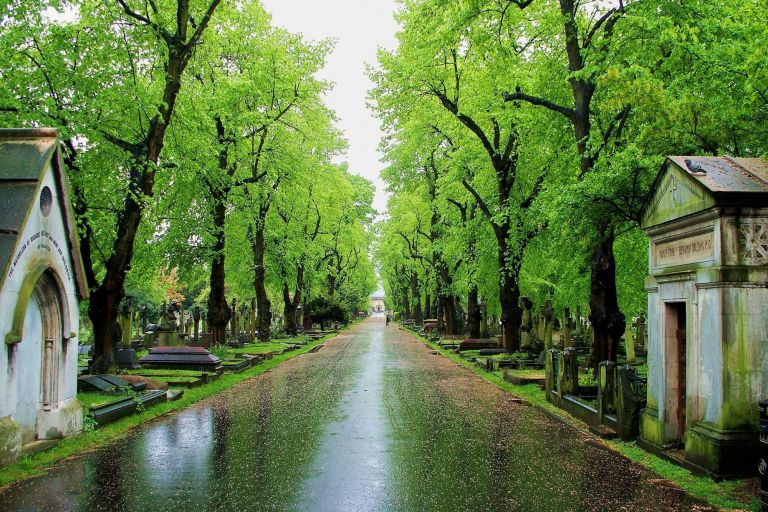
Brompton Cemetery is one of London’s “Magnificent Seven” Victorian garden cemeteries. It covers a site of 16.5 hectares (41 acres) between Old Brompton Road and Fulham Road on the western edge of the London Borough of Kensington and Chelsea. It is the UK’s only Crown Cemetery and is managed by the Royal Parks under contract from the Secretary of State for Culture, Media and Sport. As a Royal Park, it is well maintained and lacks the wildness of the other "Magnificent Seven" cemeteries. It is a Conservation Area and is also classed as a Site of Nature Conservation and Metropolitan Open Land.
Address: Brompton Cemetery, Fulham Road, London SW10 9UG (Map: OS grid reference TQ257777)
History
Brompton Cemetery was opened in 1840 by the West London and Westminster Cemetery Company, which had been established in 1836 by Stephen Geary, an architect and inventor who had previously founded the cemeteries at Highgate and Nunhead. The site, purchased from Lord Kensington, was a simple flat rectangle half a mile long without any trees because it had formerly been a market garden. A grandiose landscaping and architecture scheme proved vastly more expensive than envisaged, leading to litigation by some of the shareholders, who persuaded the government to nationalise the cemetery under powers included in the Metropolitan Interments Act of 1850 (the main purpose of which was to prohibit further burial in congested urban churchyards). Brompton was the only private cemetery to be purchased by the government before the 1850 Act was repealed by the 1852 Metropolitan Burials Act. It is still Britain's only Crown cemetery, held for the past 50 years in the care of the Royal Parks.
Habitat
The cemetery habitats include acid grassland, roughland, scattered trees, scrub, secondary woodland, semi-improved neutral grassland and vegetated walls and tombstones. The grassland shows a rough division between neutral (over former arable land) and acid (over former meadow), with neutral grassland covering most of the site and acid on some of the western lawns. Because of its enclosing walls, the cemetery has retained a number of plant species typical of the 19th century countryside and not now common elsewhere in London. In addition, there are plants such as wild cabbages, garlic, radishes and strawberries that survive from when the site was a market garden. Trees (more than 60 species) are present throughout the site, occasionally forming a closed canopy. Small-leaved lime, common limes, holm oak and horse chestnut are the most abundant species. Dense bramble scrub occurs in places. Many of the tombstones are covered with ivy, and male-fern and hart's-tongue are frequent on the brick boundary wall with the West London railway line.
Species
Birds
Among the birds that inhabit the cemetery are many garden species, wood pigeon, carrion crow and green woodpeckers. There are also a small number of non-native pairs of ring-necked parakeets with their distinctive bright green plumage and striking red beaks.
Mammals
Mammal surveys report the presence of a number of species and emphasise the value of the site for the Pipistrelle bat, house mice, wood mice, shrews, grey squirrels and foxes.
Invertebrates
The cemetery attracts a good range of butterflies ,notably the Purple Hairstreak and over two hundred species of moth. Other invertebrates include Field grasshoppers, Small White, Meadow Brown, and Cinnabar Moth caterpillars, and the Red Tailed bumblebee.
Plants
The majority of the site comprises semi-improved neutral grassland dominated by False Oat with much Red fescue, Yorkshire Fog and Rough Meadow grass. Herbs include Lady’s Bedstraw, Birds Foot Trefoil, Meadow Vetchling, Black Knapweed, Smooth Rare, Broadleaved Everlasting Pea and Oxeye Daisy. The London notables Grey sedge, Sheep’s fescue (Festuca ovina) and Dark Mullien (Verbascum nigrum) are also present. Patches of acid grassland contain Red fescue, Sheep’s sorrel, Mouse Eared hawkweed and the aforementioned Sheep’s fescue. Within the grassland are many vegetated tombstones and the wall separating Brompton Cemetery from the West London and District Railway supports Male and Harts Tongue ferns. There are many fine mature trees including, False acacia, Evergreen oak, Turkey oak, Weeping ash, Scott’s pine, Horse chestnut, London plane, common lime and yew.
Practicalities
Directions
There is no on-site public parking, and finding a parking space in the surrounding streets may be difficult. However, the cemetery is easily approached by public transport. The north gate is just yards from West Brompton station (mainline railway and London Underground District line). Bus routes 14, 74, 211 and 414 pass the cemetery. Other nearby bus routes are 190, 328, 430, C1 and C3.
Access
The cemetery has two entrances: the south gate on Fulham Road and the north gate on Old Brompton Road. The cemetery is open from 8am to 8pm in summer and 8am to 4pm in winter. Well maintained footpaths across a flat site make it suitable for wheelchair users.
Facilities
Toilets on the south side of the cemetery church, which is at the south end of the cemetery.
Attributions: Content originally by Andrew Haynes, updated by the LNHS webmaster. Top image: Royal Parks website.

